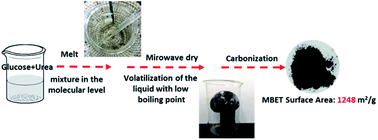A N-doped porous carbon derived from deep eutectic solvent for adsorption of organic contaminants from aqueous or oil solution†
Abstract
Porous N-doped carbon material (NCM) derived from deep eutectic solvent (DES) is successfully prepared. The preparation of NCM depends mainly on heating treatment and does not demand activation and filtration. The heating process contains three steps: (1) forming a DES that consists of glucose and urea at 100 °C; (2) preparing dried precursors by microwave; (3) and carbonizing the precursor. After heating, the resulting NCM can be obtained. The as-prepared NCM exhibits high specific surface area, rich micropores and strong Lewis basicity. Accordingly, NCMs show good adsorption performance for 4-nitrophenol or methylene blue in aqueous solution and thiophenic sulfurs in the oil phase. Apparently, NCM derived from DES not only possesses a simple preparation process, but also can remove a wide spectrum of organic pollutants. Therefore, the NCM prepared here may be promising for practical application.



 Please wait while we load your content...
Please wait while we load your content...